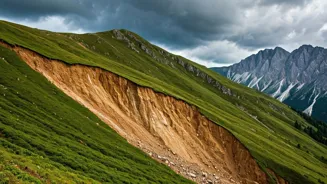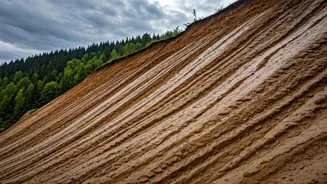Geological Vulnerabilities
Darjeeling's terrain is inherently susceptible to landslides due to its unique geological composition. The region is part of the Himalayas, a young and tectonically
active mountain range. This means the area is still being formed, and the rock formations are often weak and fractured. These rocks are easily eroded by water and susceptible to movement. Furthermore, the steep slopes and heavy rainfall patterns contribute to the instability of the hillsides. The combination of these factors creates a high-risk environment for landslides, making Darjeeling particularly vulnerable to such disasters. The geological fragility forms the foundation of the threat.
Causes of Landslides
Several factors trigger landslides in Darjeeling. Intense rainfall is a primary driver, saturating the soil and making it heavy, causing it to lose cohesion. Deforestation also plays a huge part by removing trees, which help bind the soil with their roots, increasing erosion. Construction activities, such as road building and urban expansion, exacerbate the problem by destabilizing slopes and altering natural drainage patterns. Moreover, climate change is increasing the frequency and intensity of rainfall, further increasing the likelihood of landslides. Human activities significantly worsen the situation, making the region even more prone to devastation.
Impact on Infrastructure
Landslides in Darjeeling have a devastating impact on infrastructure. Roads and highways are frequently blocked, disrupting transportation and isolating communities. Bridges can be destroyed, cutting off essential routes for supplies and emergency services. The landslides can damage or destroy buildings and houses, leaving people homeless and causing economic losses. These disruptions hinder development and make it difficult to maintain essential services. The destruction of crucial infrastructure has a ripple effect, negatively affecting livelihoods and the overall well-being of people, illustrating the urgency for infrastructure improvements.
Defense Implications
The impact of landslides extends beyond the local community. They also have implications for national security, particularly in the context of defense. Disruptions to transportation networks can hinder the movement of troops and supplies, crucial for defense operations, particularly in the border regions. The damage to infrastructure, such as roads and communication lines, can impair surveillance capabilities and strategic defense initiatives. Additionally, landslides can affect the ability to deploy military forces and respond to threats or emergencies promptly. The strategic importance of Darjeeling makes these disruptions a serious concern.
Mitigation Strategies
Addressing the risk of landslides requires a multi-pronged strategy. Implementing effective early warning systems is crucial, providing time for evacuation and reducing casualties. Reforestation and afforestation efforts can help stabilize slopes and reduce soil erosion, thereby decreasing the chance of future landslides. Improving land-use planning and regulating construction activities can also reduce the destabilization of slopes and prevent further damage. Investing in infrastructure improvements, such as building retaining walls and drainage systems, is vital for protecting key assets and critical routes. These measures are essential for safeguarding the area and protecting lives and infrastructure.
Community Preparedness
Community involvement is essential for preparing for and responding to landslides. Awareness campaigns can educate residents about the risks and what actions to take in case of an emergency. Promoting training in disaster response and first aid can improve the community's capacity to help. Building community-based disaster management teams and making emergency shelters accessible can increase safety and reduce harm. Encouraging local participation in planning and decision-making will enhance the effectiveness of mitigation efforts. Community participation is key to creating a strong and resilient response to disasters.




